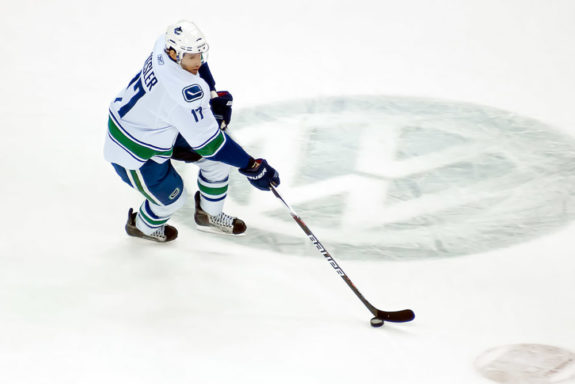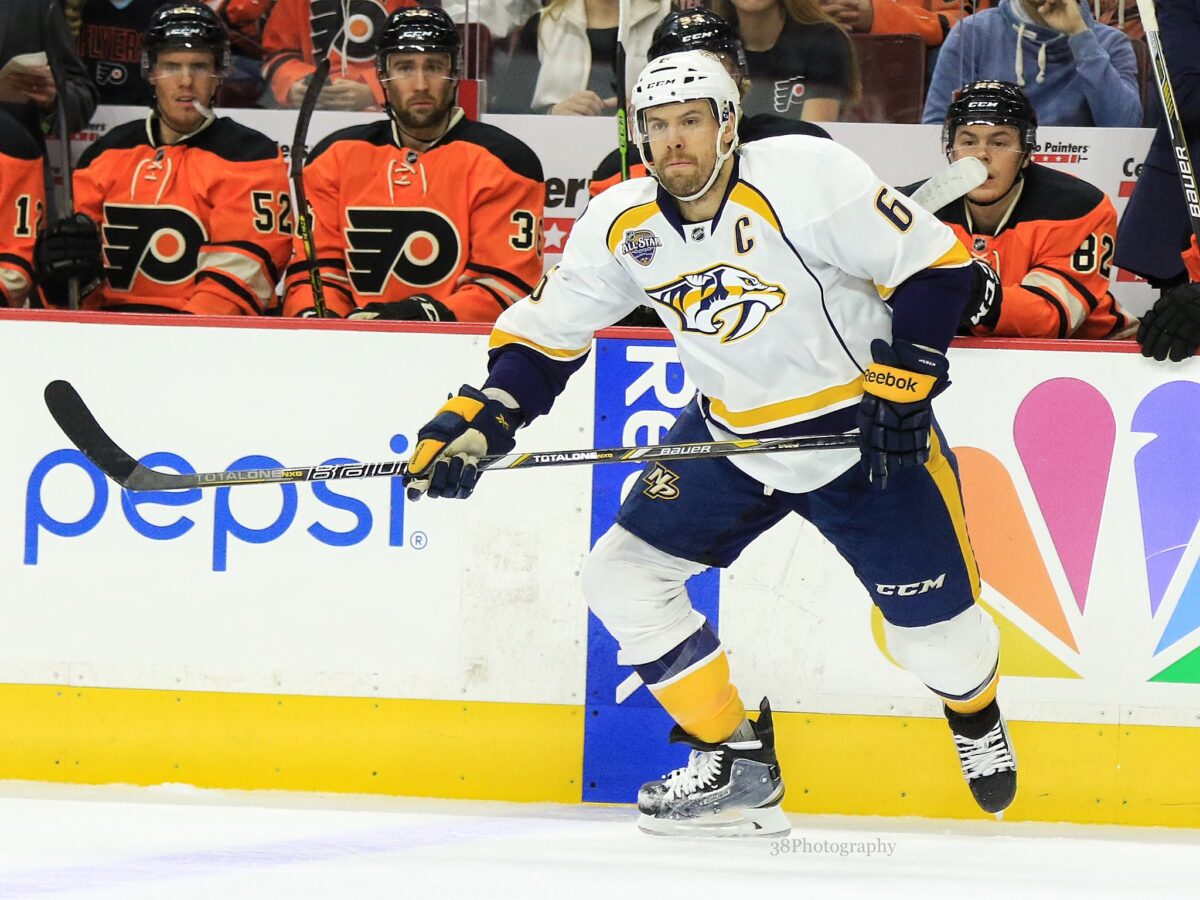Last week, the hockey world received the rarest type of offseason news: an offer sheet. Two offer sheets, at that, both tendered by the St. Louis Blues to Edmonton Oilers forward Dylan Holloway and defenseman Philip Broberg.
The Oilers still have until Tuesday to decide whether to match the offer sheet, but given Edmonton traded for forward Vasily Podkolzin from the Vancouver Canucks and defenseman Ty Emberson from the San Jose Sharks, the writing may be on the wall. If completed, the Oilers would receive a third-round pick for losing Holloway and a second-round pick for losing Broberg. It would also double the number of successful offer sheets in the salary cap era.
However, the history of the offer sheet goes back much further, as the first was tendered in 1986. And some of the most noteworthy offer sheets ultimately were matched but still wound up having an impact.
The Blues are the undisputed kings of the offer sheet, tendering a whopping 12 of them, three times more than any other team. However, the Philadelphia Flyers have a strong case to at least be on the podium. Only the Blues, New York Rangers, and San Jose Sharks have tendered more offer sheets than Philadelphia’s three. The Flyers are also one of the three teams to have signed multiple offer sheets during the salary cap era (the Blues and Oilers are the others.) So, before the Oilers make their choices and any other teams can change those numbers, let’s revisit Philadelphia’s three offer sheets and see what mark they left on the Flyers and the NHL landscape.
Chris Gratton (1997)
If you’re a reader of The Athletic’s Sean McIndoe (or Down Goes Brown), you may have read about this just a few days ago (from ‘Ten weird NHL facts that bother me more than they should,’ The Athletic, Aug. 16). Chris Gratton was coming off a breakout 1996-97 season, his fourth in the NHL, leading the Tampa Bay Lightning with 62 points. The 6-foot-4, 226-pound center fit perfectly with the identity of the Flyers, who signed him to a five-year, $16.5 million contract.
The Lightning decided not to match, reaping a massive haul of four first-round picks. However, Tampa Bay general manager (GM) Phil Esposito wanted more immediate help. So, he traded those picks back to Philadelphia for forward Mikael Renberg and defenseman Karl Dykhuis. Renberg was a beloved piece in Philadelphia, a key part of the Legion of Doom line alongside Hockey Hall of Famer Eric Lindros and five-time all-star John LeClair.
Still, Renberg was a big body (6-foot-3, 235 pounds) who put up 82 points as a rookie in 1993-94 and was productive in the next three seasons. Dykhuis wasn’t as well-established, although he can claim one of the weirdest playoff overtime goals ever to his name. But thanks to this transaction, they are the only players ever traded for four first-round picks.
Gratton’s first year in Philadelphia was a dream — another 62-point campaign and a trip to the Stanley Cup Final. However, Gratton only played in five playoff games. After playing 26 games in 1998-99, the Flyers traded him back to the Lightning alongside Puckdoku legend Mike Sillinger for Daymond Langkow and… Renberg, who struggled during his season-plus in Tampa Bay.
The nostalgia didn’t last long. Renberg only remained a Flyer for about a year before being traded to the Phoenix Coyotes and finished his career after three seasons with the Toronto Maple Leafs. Gratton also bounced around, playing for five more teams before calling it a career in 2009. He was traded four more times, including a deal between the Coyotes and Buffalo Sabres that involved future Flyers player and current GM Danny Brière.
Oh, and don’t worry about Dykhuis — he was also traded back to his original team in a separate deal in 1999. The Flyers moved him to the Montreal Canadiens in 1999, where he stayed until his NHL career concluded in 2004.
The ultimate what-if is if the Lightning had just held on to the draft pick compensation. All of Philadelphia’s first-rounders from 1998 to 2001 fell outside the top 20. However, the Flyers still unearthed gems in Simon Gagne (who eventually made his way to Tampa Bay) and Justin Williams. Those players could have been building blocks for a Lightning team that won the 2004 Stanley Cup (beating the Flyers in a seven-game Eastern Conference Final) but only won one other playoff series until 2011.
As for the Flyers, though Gratton was productive, maybe Renberg would’ve been able to contribute more in the playoffs and helped the team at least hang around with the mighty Detroit Red Wings, who finished them off in a clean sweep.
Ryan Kesler (2006)
The Flyers were the first team to tender an offer sheet during the salary cap era right around the start of training camp in 2006. The Canucks nabbed Ryan Kesler one pick before the Flyers’ second first-round selection in the stacked 2003 Draft at No. 23 overall (the Flyers did just fine, drafting Mike Richards instead.) But they attempted to have their cake and eat it, too, with Kesler unsigned by Vancouver and still looking to establish himself as an impact player. He played all 82 games in 2005-06, his first full NHL season, and registered a modest 23 points.
It had been several years since an offer sheet had been dished out, but the Flyers had a hole at center with Keith Primeau retiring. It was a one-year contract worth $1.9 million, although the salary cap ceiling was exactly half what it is today. Still, Canucks GM Dave Nonis matched the contract. That proved a wise call, as Kesler broke out a few seasons later and enjoyed a successful 15-season career that included a Selke Trophy and a 2011 Finals appearance with Vancouver, becoming a franchise icon.

The Flyers would’ve been stacked down the middle for a long time with a trio of Carter, Richards, and Kesler (not to mention Claude Giroux, who the Flyers had drafted a few months before the offer sheet.) Kesler wouldn’t have saved the Flyers from a nightmare 2006-07 season, and given the Flyers finished 15 points behind the draft lottery-winning Chicago Blackhawks, they probably don’t wind up with Patrick Kane, either. Perhaps the Flyers go with a defenseman with Kesler in the fold instead of James van Riemsdyk at second overall, although the first two defenders off the board (Thomas Hickey and Karl Alzner) had good-but-not-great careers.
Still, we’re talking about a transaction that could have altered two Stanley Cup Finals (Philadelphia’s run in 2010 and Vancouver’s in 2011). If anything, the one regret Flyers GM Bobby Clarke here is not making a more aggressive offer that could’ve gotten the Canucks to call uncle.
Shea Weber (2012)
This is arguably the most well-known offer sheet in NHL history. And in terms of total dollars, it’s the second-largest contract in NHL history, trailing only the 13-year, $124 million extension Alex Ovechkin signed with the Washington Capitals in 2008.
After reaching the 2010 Stanley Cup Final, the Flyers suffered back-to-back second-round defeats but still believed they could contend. However, they needed to replace number-one defenseman Chris Pronger, whose career was sidetracked by injuries early in the 2012 season. They’d also just lost another top-four staple to unrestricted free agency in Matt Carle, yet another member of the surprisingly-large “played for Flyers and Lightning” club.
GM Paul Holmgren wasn’t messing around with finding a new blue liner. Shea Weber had established himself as a franchise face for a Predators team that had just won its first-ever playoff series in 2012. He had it all — physicality, defensive prowess, and a cannon of a shot that had already produced five 15-plus goal seasons, a rarity for a defenseman.
Nashville is a small market in the NHL world, and the Flyers attempted to use that to their advantage. Not only did they sign Weber to a jaw-dropping 14-year, $110 million contract, but they heavily front-loaded the deal to dissuade the Predators from matching. It was as bold of a decision as a GM can make.

But matching such a whopping deal is up there, too, which is what Nashville GM David Poile did. Weber remained a Predator for four more seasons until the equally seismic one-for-one trade in 2016, which sent Weber to Montreal for PK Subban. Both Weber and Subban reached a Final with the team they were traded to. However, Nashville probably made out better overall since they managed to trade Subban for value (Weber has been on long-term injured reserve since 2021 and is now technically Vegas Golden Knights property) and have six playoff trips (seven if you count a 2020 qualifying-round loss in the bubble) to Montreal’s three since the deal.
The Flyers have four playoff appearances since offer-sheeting Weber but just one series win. The Flyers definitely would have been better off in the short term with Weber, although it’s tough to say he could have pulled the team into contention single-handedly. Perhaps adding Weber would have encouraged other free agents to come to Philadelphia and another Stanley Cup push could have come to pass. Signing Weber wouldn’t have guaranteed success, and who knows what happens to Subban in this scenario. It’s not the only near miss the Flyers have had with an elite defenseman in recent memory, adding to the sting.
Next Up?
There are still a lot of restricted free agents (RFAs) out there. But don’t expect the Flyers to make a big push — after all, they’re technically over the salary cap right now (don’t worry, putting Ryan Ellis on LTIR is an easy fix) and their roster largely seems set.
However, the 2025 and 2026 offseasons offer more intrigue. The Flyers should have more cap space, and with Matvei Michkov set to debut this season, the team’s sense of urgency could be heightened. The next offseason features a lot of young defenders on the RFA market such as Evan Bouchard, Noah Dobson and Luke Hughes.
Related: Eric Lindros Trade Revisited
Chicago will likely extend Connor Bedard the first chance they get, but 2026 sees potential Flyers trade targets Trevor Zegras and Shane Pinto become RFAs, among others. The Flyers have three first and second-round selections in 2025, which could make them more comfortable with parting with other picks.
It’s still not likely an offer sheet will come around given just how rare they are. But the Flyers love to make big moves, and maybe the stars align for another special occasion of this rarely-used tactic.